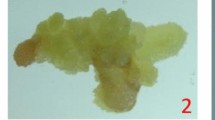Abstract
An in vitro embryo culture protocol was developed for Scirpus acutus Muhl. A maximum of 85.6% of germination was obtained when isolated embryos were cultured in vitro, a result similar to those reported in the literature with traditional dormancy breaking treatments. In vitro seedling development was optimal in half-strength Murashige and Skoog (1962) liquid medium. An average of 3–4 shoots were produced from the initial seedlings. Clusters of plantlets were successfully acclimatized and transferred to soil. These results corroborate the findings of previous studies stating that seed dormancy in Scirpus is caused by the seed/fruit coats. In vitro embryo culture thus allows for the production of Scirpus acutus Muhl. seedlings that can be transferred to natural or artificial wetlands.
Similar content being viewed by others
References
Bewley JD &; Black M (1982) Physiology and biochemistry of seeds. In: Viability, Dormancy and Environmental Control Vol. 2. Springer-Verlag, Berlin
Bradbeer JW(1988) Seed Dormancy and Germination. Blackie and Son Limited, London
Clevering OA (1995) Germination and seedling emergence of Scirpus lacustris L. and Scirpus maritimus L. with special reference to the restoration of wetlands. Aquat. Bot. 50: 63–78
Clevering OA &; van Gulik WMG (1997) Restoration of Scirpus lacustris and Scirpus maritimus stands in a former tidal area. Aquat. Bot. 55: 229–246
Giroux JF &; Bedard J (1995) Seed production, germination rate, and seedling establishment of Scirpus pungens in tidal brackish marshes. Wetlands 15: 290–297
Hamilton H, Nix PG &; Sobolewski A (1993) An overview of constructed wetlands as alternatives to conventional waste treat-ment systems. Water Poll. Res. J. Canada 28: 529–543
Hu C &; Wang P (1986) Embryo culture: technique and applications. In: Evans DR, Sharp WR &; Ammirato PV (eds) Handbook of Plant Cell Culture. Techniques and Applications Vol. 4 (pp. 43–96). McMillan Publishing Co, New York
Lacroix C &; Mosher C (1995) Early development and viability testing of embryos of Scirpus acutus Muhl. Aquat. Bot. 50: 117–125
Lentz K &; Johnson HA (1998) Factors affecting germination of endangered northeastern bulrush, Scirpus ancistrochaetus Schuyler (Cyperaceae). Seed Sci. Technol. 26: 733–741
Murashige T &; Skoog F (1962) A revised medium for rapid growth and bioassays with tobacco tissue cultures. Physiol. Plant. 15: 473–497
Thullen JS &; Eberts DR (1995) Effects of temperature, stratifica-tion, scarification, and seed origin on the germination of Scirpus acutus Muhl. seeds for use in constructed wetlands.Wetlands 15: 298–304
Vincent G (1992) Artificial marshes to maintain water quality: the Beach of Ile Notre-Dame, Montreal. Water Poll. Res. J. Canada 27: 327–339
Vincent G (1994) Use of artificial wetlands for the treatments of recreational wastewater. Wat. Sci. Tech. 29: 67–70
Author information
Authors and Affiliations
Corresponding author
Rights and permissions
About this article
Cite this article
Lauzer, D. In vitro embryo culture of Scirpus acutus Muhl.. Plant Cell, Tissue and Organ Culture 76, 91–95 (2004). https://doi.org/10.1023/A:1025823927651
Issue Date:
DOI: https://doi.org/10.1023/A:1025823927651




